Don’t like running? You don’t have to. Even though treadmills are great, they’re not the only piece of cardio equipment that can get you in tip-top shape. Rowing machines will bring you a wealth of strength and conditioning benefits — without all that repetitive impact on your joints.
Rowing is a low impact, functional exercise that is relatively easy to learn. It’s a great tool for building well-rounded fitness, and you can use it in both high-intensity training sessions and low-intensity recovery workouts. Learning to set-up the rower and execute the proper technique is essential to getting the most out of this machine — and mastering a diverse array of workouts can help a lot, too.
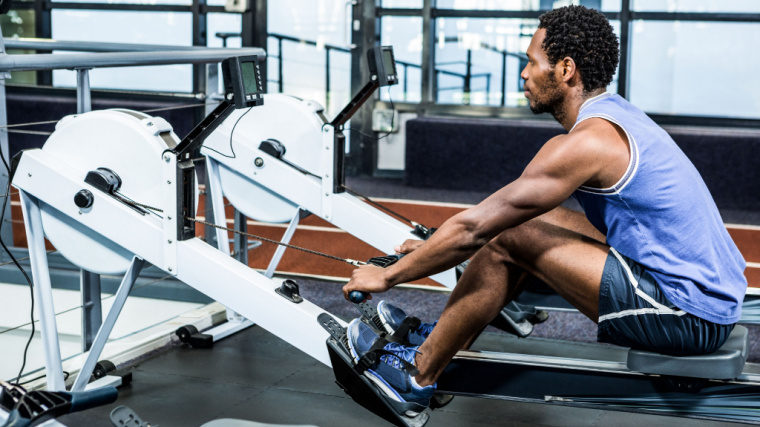
Below are 12 rowing workouts catered to every experience level. Pacing practice and baseline testing to kick off the first four workouts. Then, you’ll find four training segments to build and improve your skills and work capacity. The final four workouts are a combination of different tests and progressions to challenge your skills and bring your fitness to the next level.
Beginner Rowing Machine Workouts
Intermediate Rowing Machine Workouts
Advanced Rowing Machine Workouts
- 10-Minute Advanced Rowing Machine Workout
- EMOM Rowing Workout for Increased Stamina
- Rowing Workout for Consistent Pacing
- Mixed Modal Rowing Workout
Beginner Rowing Machine Workouts
It’s essential to understand the basic units and data listed on the rower monitor. As you get started, you’ll need to know how to read your average 500-meter pace (/500m). You’ll also need to know your stroke rate (s/m).
Rowing Machine Workout for Pacing
The goal for this workout is to learn how to pace on the rower, utilizing the average 500-meter metric listed on the screen. You’re rowing for two minutes. The effort should feel challenging, but the number on the screen should not change much. This will take practice to figure out and will require a high level of focus. Your mindset approach to this should be more of a game than a workout in the traditional sense.
The Workout
5 sets
- 2:00 Row @ consistent average 500-meter pace
- 1:00 Rest
Try to see how consistent you can be across the two minutes and attempt to repeat those efforts for all five intervals. You needn’t be left lying on the floor in a puddle of sweat at the end of this workout. Instead, keep the pace consistently tough, but manageable.
Rowing Machine Workout for Stroke Consistency
This next workout is focused solely on the stroke rate (s/m) listed on the screen of the rower. Your stroke rate refers to how many times you’re pulling (going back-and-forth) each minute.
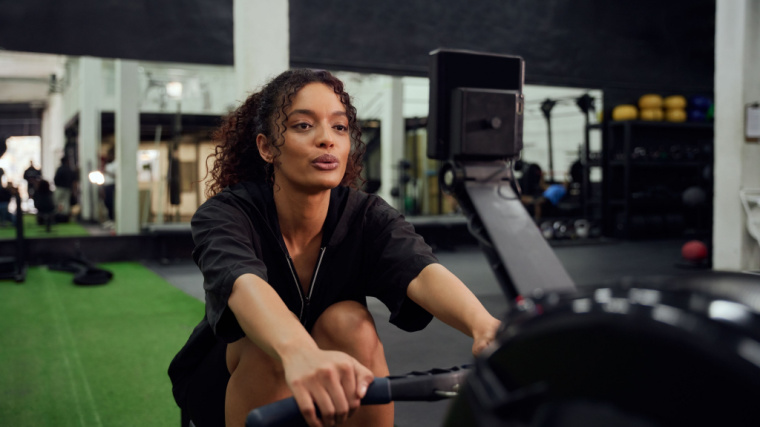
Beginners often come out hot and heavy with a high stroke rate. But this can leave you exhausted without much work accomplished. This workout will teach you to maximize the meters per pull, allowing you to be more efficient and save energy. If you’re a shorter athlete, you may naturally have a higher stroke rate and you might aim for 28 to 32 strokes per minute as a starting point. If you’re a taller athlete, you might aim for 22 to 28 strokes per minute.
The Workout
10 sets
- 1:00 Row @ consistent stroke rate
- 1:00 Rest
The intensity of this workout will be dictated by the strength and energy you put into each stroke, not how fast you row back-and-forth. The main focus for this workout is the consistency of the stroke rate and figuring out what feels best for you during this time domain (one minute efforts).
Beginner Rowing Machine Workout for Speed
Rowing for 500 meters can give you a speed baseline for your other rowing machine workouts. This will be a fast, high intensity effort. Don’t worry about the average 500-meter pace or stroke rate here — only focus on rowing with proper technique.
The Workout
For time:
- 500-meter Row
Hit this workout at a near-maximum effort, as you can compare this result with subsequent workouts to figure out where you need to specifically improve. Think about it like finding your one-rep max with barbell lifts.
Just as you base the load and intensity of your workouts on percentages of your one-rep max, you’ll set intensity goals and expectations for rowing workouts largely based on your 500-meter time.
Beginner Rowing Machine Workout for Stamina
The 2,000-meter row is your standard stamina test for the rower. Many athletes will take six to ten minutes to complete this one. It’s extremely important to pay attention to the average 500-meter pace and stroke rate during this test.
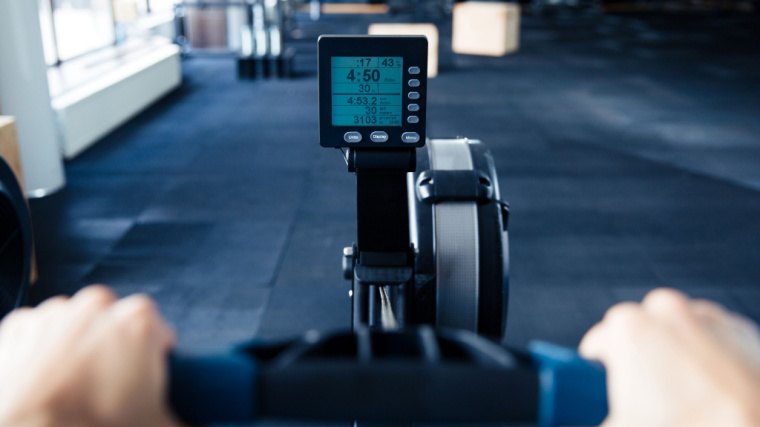
Most beginners will come out too fast and quickly see their pace fall off as they slide into the pain cave. It’s best to hit the first 1,000 meters conservatively and then incrementally pick up speed from there. You will compare this time to your 500-meter time to see if you need to focus on speed or stamina work.
The Workout
For time:
- 2,000-meter Row
Regardless of whether your weakness is speed or stamina, be sure to integrate both types of workouts in your training. The difference is that you should target your weakness with more frequency and volume than your strength.
Intermediate Rowing Machine Workouts
As you get more experienced with a rower, your workouts may call for you to pay attention to another number on the screen — your calories spent during your workout.
Note: Some athletes may want to avoid looking at any kind of calorie count. This number is used to indicate effort in these workouts — calories of energy spent rather than “burned.” However, using calorie counts of any kind might still be a pain point for some athletes. If need be, substitute calorie-based workouts by performing a higher-than-normal stroke rate or meters for the given amount of time or strokes.
For folks comfortable using this feature, to switch your screen’s view from meters to calories, you will need to click on the “units” button. You can adjust the data you see by pressing the “display” button.
Intermediate Rowing Machine Workout for Speed
This interval workout is a total of 1,500 meters of rowing, with one minute of rest after each 250-meter effort. The goal here is to row your first 250 meters at your best 500-meter pace.
Each interval, try to row at a pace of one to two seconds faster than the previous set.
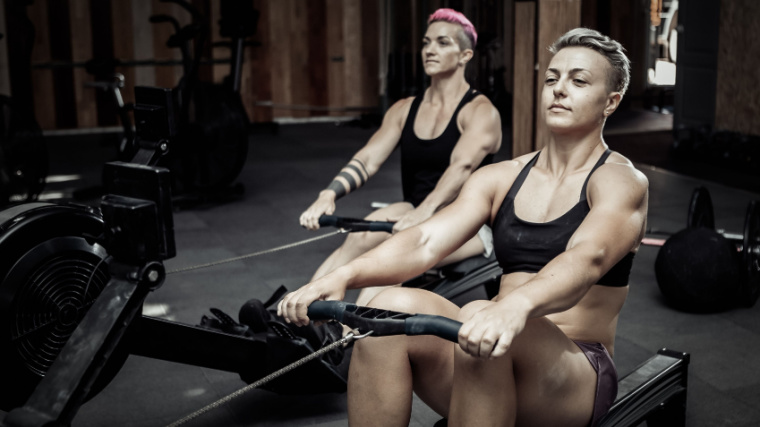
For example, if you row your first 500 meters in 2:45, aim to increase your second set to 2:43-2:44 pace. Follow this trend each interval, incrementally increasing your pace until the sixth set.
The Workout
6 sets
- 250-meter Row
- 1:00 Rest
This will progressively become more challenging and will teach you to push harder towards the end of your workouts.
Rowing Machine Workout for Endurance
For this workout, it’s important to know the average 500-meter pace from your 2,000 meter time trial. You will be basing the target pace off this number to maximize the workout.
You’re going to row for three minutes at your pace minus five seconds. For example, if you rowed 2,000 meters at a 2:50/500-meter pace, aim to hold a 2:45/500-meter pace for this entire workout.
The Workout
4 sets
- 3:00 Row
- 1:00 Rest
If you’re able to hit your target paces, attempt this again a few weeks later. Remove another one to two seconds from the pace to continue building capacity.
Rowing Machine Workout for Max Calories
This next workout introduces rowing for calories to your progression. You will get twenty strokes per set, meaning you only get to pull the chain 20 times. The goal is to maximize your stroke rate and learn to pull with power. Focus your energy on long and strong pulls, emphasizing technique using your legs, core, and finishing with your arms.
If you’d like to avoid using calories as your gauge, focus on pulling as many meters as you can with only 20 strokes.
The Workout
5 sets
- 20 Strokes for max calories (or meters)
- 1:00 Rest
Your score for this workout is the lowest calorie set — or the lowest amount of meters — so be sure to push hard, but be consistent.
Rowing Machine Workout for Technique
This workout tests your ability to row at different speeds with minimal recovery. It’s extremely important to be able to feel the difference between an easy, moderate, and hard effort. That means something different for everyone, and you’ll learn how to do that here.

The first set is meant to help you figure out what the different goal paces will be for the easy, moderate, and hard segments. For each part of the workout, try to hold the same pace for the full 30 seconds before moving to the next speed segment.
The Workout
8 sets
- 0:30 Row (easy)
- 0:30 Row (moderate)
- 0:30 Row (hard)
- 0:30 Rest
Each interval can be for total calories — the goal is to hit the exact same number of calories each set. If you prefer not to use calories as a measure, record your meters instead.
Advanced Rowing Machine Workout
Once you’ve gotten a feel for your own form and for the beast that is a rowing machine, it’s time to up the ante of your rowing workouts.
10-Minute Advanced Rowing Machine Workout
The goal is to be consistent with the pace for the first five minutes. Then, incrementally speed up each minute until the final minute. Your last minute should be the fastest pace of the workout. This is a weekly progression where your goal is to beat the previous week’s score.
Perform this workout once per week until you feel like you won’t be able to keep progressing the following week. Typically you improve for about four to six weeks, depending on your starting point.
The Workout
10-minutes:
- Row for max calories (or meters)
It’s important to perform week one at about eighty percent effort to get a feel for the workout and leave some room for gains in the upcoming weeks.
EMOM Rowing Workout for Increased Stamina
The goal of this workout is to test your rowing stamina. The number of calories (or meters) you hit in the first minute is the number you must repeat for the remaining nine rounds. If you do this right, the final three to four minutes will be extremely difficult.
The Workout
Every minute on the minute (EMOM) for 10 minutes:
- 0:40 Row for calories (or meters)
- 0:20 Rest
Due to the intensity of this workout, you might want to avoid it as a weekly progression. Instead, use it as a benchmark to test yourself every two or three months.
Rowing Workout for Consistent Pacing
This workout is a test of your ability to feel and execute consistent pacing. You’re going to keep the monitor down in the stored position for each interval so you’re unable to see the screen as you perform each set. The goal is to hit the same number of calories (or meters) every set.
The Workout
8 sets:
- 2:00 Row for calories (or meters) with the screen not visible
- 1:00 Rest
For every calorie (or every 10 meters) you are over or under from the first set, perform as total burpees at the end of eight sets.
Mixed Modal Rowing Workout Rowing
Now that you have built a solid foundation of rowing fitness and learned what your paces and stroke rates are for different styles of workouts, you’ll test your knowledge — and work capacity — in a mixed workout.
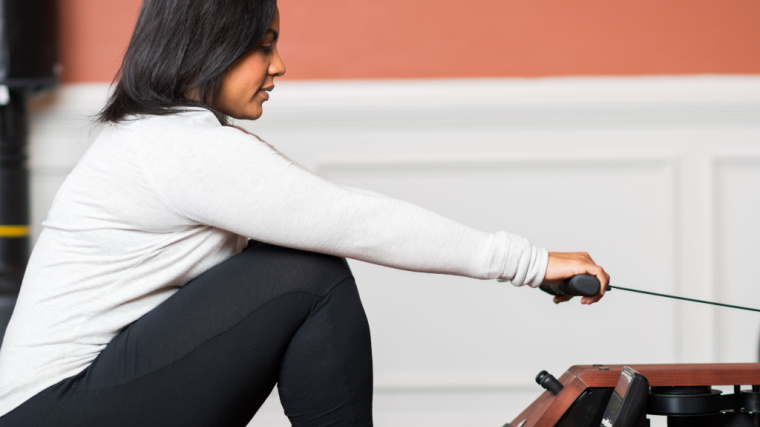
The intention for the burpees is to move at a steady, nonstop pace. Try to complete your wall balls with no more than one break per round. Adjust the target height and ball weight to accomplish this.
The Workout
4 rounds for time of:
- 15 Burpees
- 30 Wall Balls
- 500-meter Row
The goal for the rowing is to find your max recovery pace while fatigued. This means finding the fastest pace you can sustain while recovering to jump back into the burpees and wall balls.
How to Row Properly
All the fitness in the world won’t help you get the most out of a rowing machine if you don’t know how to use it properly. Check out these essential rowing machine form tips to get yourself going.
Getting Ready to Row
If you’re unfamiliar with rowing, it’s important to set yourself up for success by getting your foot straps and damper set-up correctly.
While it might be tempting to crank up the resistance all the way to 10, know that even expert rowers often perform their 2,000-meter tests on level five or six. Strap your feet in, adjusting the sizing so that the strap is secure over your midfoot.
Rowing Technique Breakdown
Taking the time and practicing drills to perfect technique pays high dividends on rowing efficiency. Better rowing technique means completing more work with less energy.
Here are the basics of proper rowing technique:
- With your feet strapped in, lean forward to grab the handle loosely. Keep your wrists relaxed but straight.
- Keep your arms straight as you lean forward from your hips so that your shoulders extend over your hips. You can lift your heels while keeping your shins relatively vertical.
- Drive your feet down, explosively straightening your legs. Keep your shoulders relaxed and away from your ears.
- Maintain straight arms until your knees start to straighten. At that point, transition into pulling with your arms. Lean back slightly with your core engaged. With straight wrists and a relaxed grip, bring the handle slightly under your ribs.
- Straighten your arms again, leaning forward from your hips. Bend your legs as your hands pass in front of your knees. Return to the starting position and repeat.
These steps will help you become more fluid and powerful as you increase speed and intensity.
Similar to lifting a barbell or performing gymnastics, it’s important to note that your intensity should never be so high that technique completely falls apart. Strive to find the threshold that has you on the edge of breakdown without allowing the form to fall apart. You’ll raise your baseline over time with consistency and practice.
Benefits of Rowing
Rowing isn’t only about cardio — although it is very good for that. It’ll also get your full body involved in a potentially fast and furious workout that can up your overall fitness in a big way.
Full Body Workout
Most cardiovascular exercises like running and biking are lower body dominant, but the rower utilizes your legs, core, arms, and back muscles. If you have limited time and are looking for a full body workout, using the rower is an excellent option.
The combined benefit of building aerobic fitness while training your muscles for strength makes rowing an efficient way to train your entire body.
High Intensity, Low Impact
Rowing is a high-intensity but low-impact alternative to cardio movements like running, which tax your joints more heavily. Training on the rower allows more frequent workouts at high intensities without so much wear and tear on your body.
Recovery
Light aerobic exercise can make for effective active recovery between intense training. Using a rowing machine for lighter sessions can help flush your system and aid with relieving muscle soreness and overall recovery.
Get to Work
No matter your experience level, there are rowing workouts that can help inject some life back into your cardio routine. Focus your energy on staying consistent with your technique and pacing.
Even if you’re an expert, there’s no need to blaze through every training session. Use these twelve rowing machine workouts as a way to give yourself unique challenges — and a boost to your overall fitness and skills — no matter how much experience you have.
Featured Image: wavebreakmedia / Shutterstock